Main Content
Is the “Invasive Species of the Month” useful to you? Let us know how.
Ampelopsis glandulosa var. brevipedunculata synonym Ampelopsis brevipedunculata
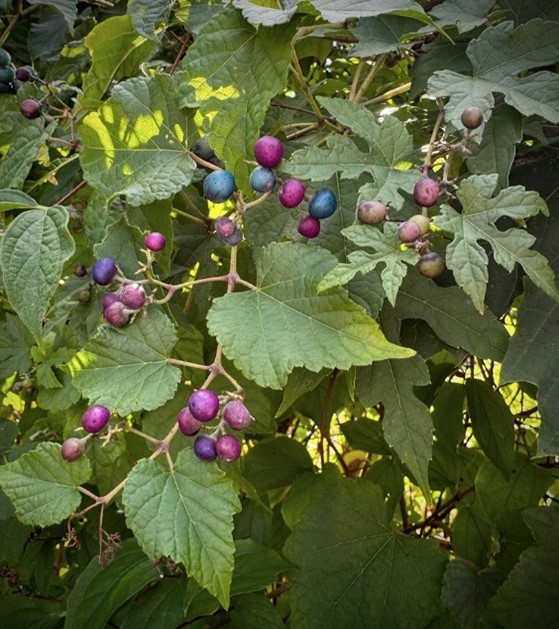
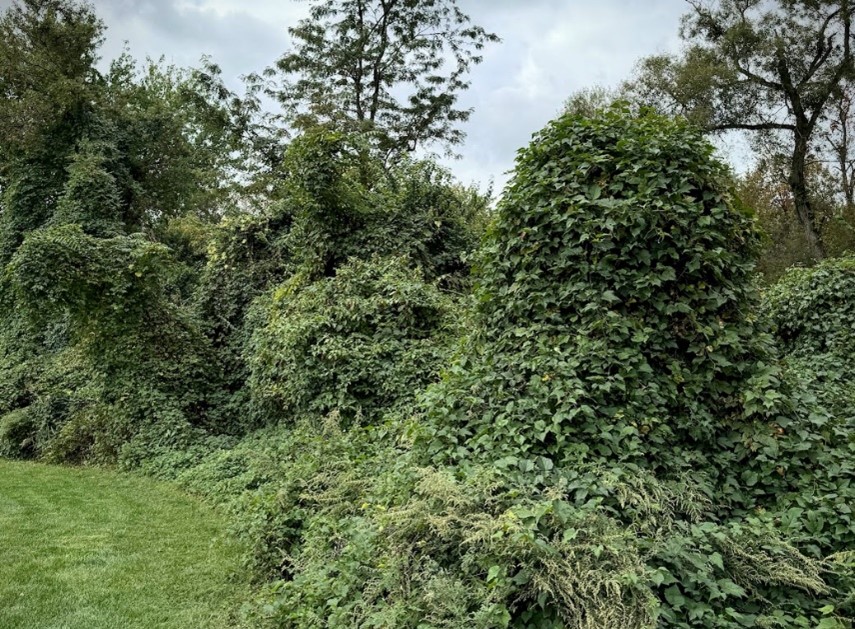
Porcelainberry, also known as Amur peppervine, (Ampelopsis glandulosa var. brevipedunculata) is a fast-growing, woody, deciduous vine (liana) that easily blankets any object or vegetation, smothering trees, shrubs, vines, herbaceous plants, and even other invasive plants. It originates from northeast Asia and was introduced to the U.S. in the 1870s as an ornamental landscape plant, it is currently widespread in the eastern U.S.
Identification: Leaves have a coarsely toothed margin, a cordate (heart-shaped) base, and are palmately lobed but vary in lobe formation and development (Figure 1). Leaves first emerge with three pointed lobes resembling native grape (Vitis spp.); with growth along the vine, leaves develop three to five deeply dissected, ornate lobes. Sometimes leaves of porcelainberry can be distinctly variegated. Young vines are green to reddish with fine hairs. As vines mature, the bark develops irregularly interlaced, slightly scaley ridges and shallow furrows, while grape vine bark peels and shreds in vertical strips. (Figure 2.)
The stem pith is white, while grape is brown. Tendrils at the nodes enable the plant to climb. Clusters of small flowers develop into berries by late summer that often appear smaller and more widely spaced on their panicles than native grape. Ripe berries are very ornamental and multi-colored from cream to turquoise, blue to purple, and magenta with a porcelain-like sheen (Figure 3).
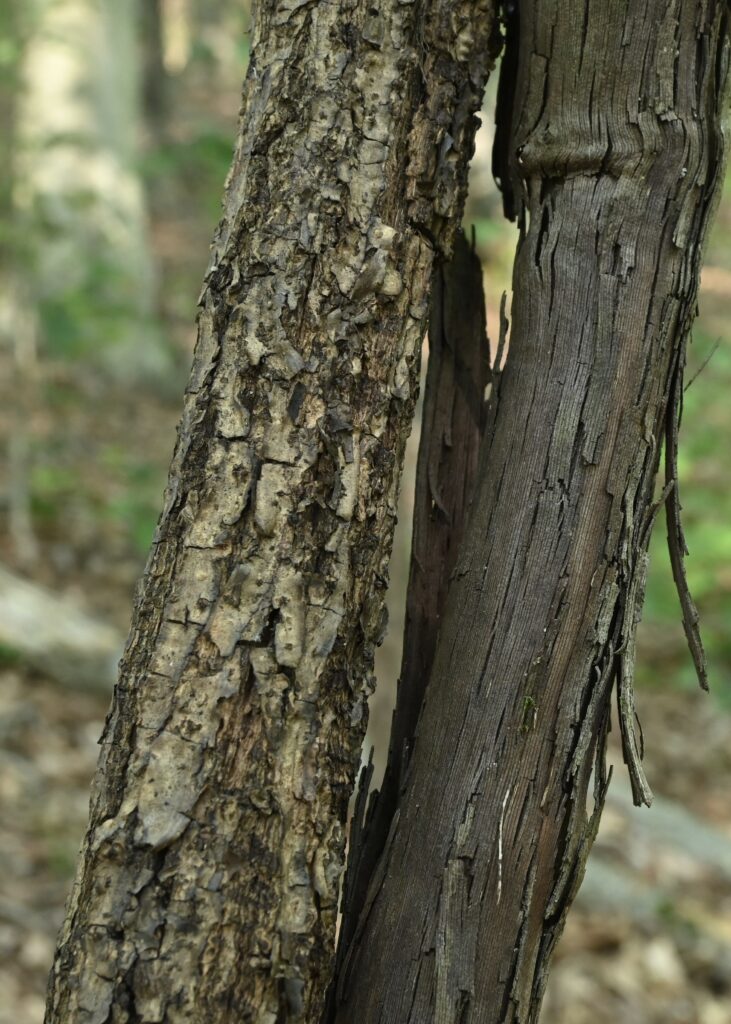
Figure 2. Comparison of porcelainberry’s mature woody vine, left, versus native grape mature vine right. Photo credit: Trish Maguire
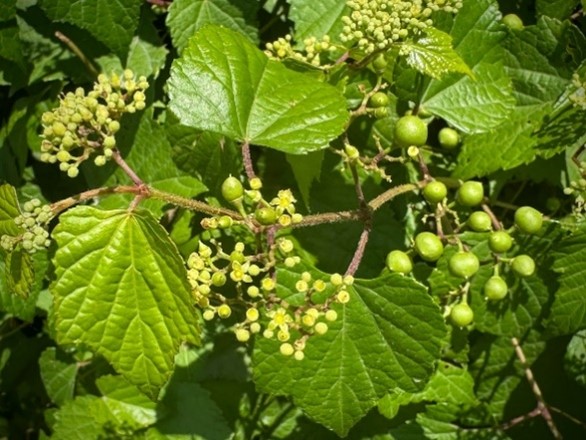
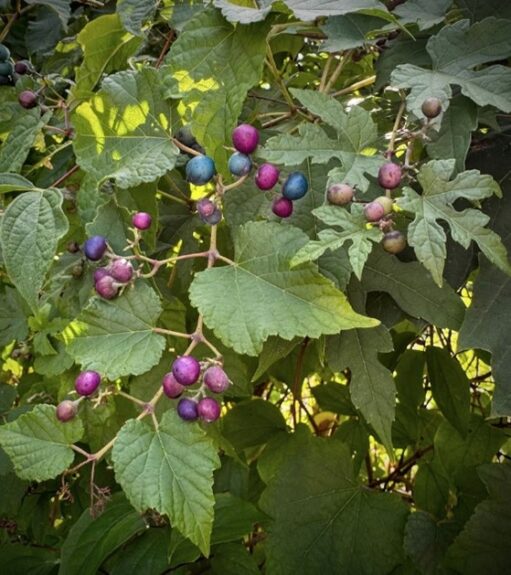
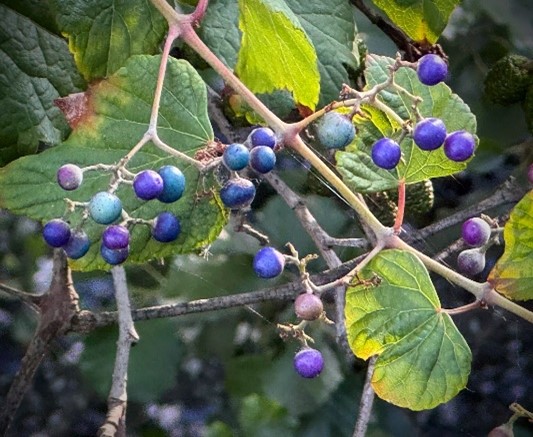
Figure 3. Flowers in summer (left) transition to green berries that turn vibrant blues, purples, and pinks by late summer to fall.
Photo credits: Jean Epiphan
Ecological threat: Porcelainberry rapidly invades and dominates. It can quickly grow into thick blankets covering all other vegetation, including trees, preventing photosynthesis and causing decline. It causes habitat loss and degradation to any site type, smothering and killing native and desirable vegetation. This results in loss of biodiversity and climate resiliency.
Method of spread: Porcelainberry spreads by seed and vegetatively. One young vine can spread with many leaders in multiple directions, re-rooting across the ground and resprouting after cutting. It fruits prolifically. Seeds are dispersed into all types of habitats by birds and small mammals that consume the berries. In managed sites, its resemblance to native grape vines enables it to grow unnoticed until it is established and reproductive.
Preferred habitat: Porcelainberry prefers open woodlands, canopy gaps, disturbed sites, edges spaces, roadsides, garden beds, and anywhere it can climb. Rich, mesic and disturbed soils facilitate rapid growth. It can invade almost any type of site from deeply shaded high-quality forests to hot and dry urban soils of inner cities.
Removal methods:
Cutting – As Pretreatment Preparation to Rescue Blanketed Trees and Shrubs
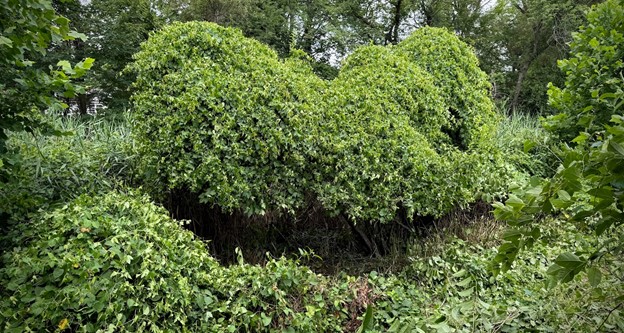
Porcelainberry often grows up and over other vegetation. Make sure to cut porcelainberry away from desirable and native vegetation before treatment. Smaller infestations can be carefully cut back to two foot or smaller lengths. Vines often sprawl into multiple directions; woody vines can be tied together with twine to aid in consolidating spot treatment areas.
For larger infestations that blanket tall shrubs and trees, employing the “window-cut” method can protect desired trees from being smothered and should be used even if the vine can’t be immediately eliminated. (Figure 4). This involves cutting the vines at ground level and cutting them again at shoulder level, which allows for low foliar or woody vine treatments at ground level without harming the non-target shrubs and trees. It also helps prevent the vines from easily climbing up again. It is critical to leave the dying porcelainberry vines in the canopy of the shrubs and trees and not pull them down, as pulling vines from the canopies will significantly damage the desirable vegetation. Do not compost cuttings or fruit.
To help prevent spread, cutting is best performed before berry formation in late summer.
Chemical – Established Vines and Populations
Herbicide treatments should be performed in the second half of the growing season; two separate treatments 30-60 days apart are recommended. Herbicide choices include premixed products labelled tough brush killer. Formulations that include glyphosate and/or triclopyr ester mixed with basal oil have been proven effective.
Foliar treatments can be performed on vines that have leaves. The cut and paint, or cut and dab, treatment method is effective for woody vines that are treated on the cut stem right after it has been cut. Established porcelainberry invasions usually require a foliar treatment followed up with a second foliar and woody vine treatment. Large vines can be treated in late fall when it is above 50 degrees F, using the cut and paint method. Always follow the herbicide label instructions; the label is the law.
Post initial treatment, make sure to monitor the area for re-sprouts and new individuals for multiple seasons. Spot treatments are often required annually.
If you are not able to or are not comfortable using herbicides, hire a landscape professional that has a pesticide license and specializes in invasive plant management.
Hand Pulling – Young Seedlings and Small Vines
Catching invasions early is critical to prevent habitat loss and long-term, costly, and challenging management. Learn how to identify porcelainberry seedlings to easily remove them by hand (Figure 5). Importantly, learn how to differentiate them from similar-looking seedlings like native grape species (Figure 6). Hand pulling small vines from wet soil is more successful; be sure to remove the root crown just under the soil. Yet, any part of the root left has the potential to re-sprout into a new vine. Do not compost removed seedlings or vines. Porcelainberry can germinate at almost any time in the growing season; regular scouting is recommended for “early detection-rapid response.” It quickly becomes deeply rooted after three to nine months of vigorous growth; removal by hand becomes impossible once it is well established.
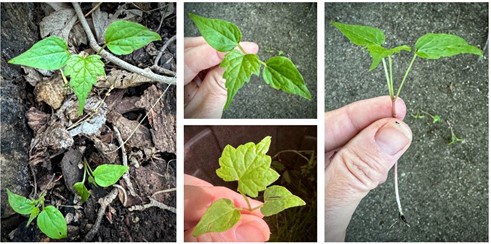
“Early detection-rapid response” is the best method for removal.
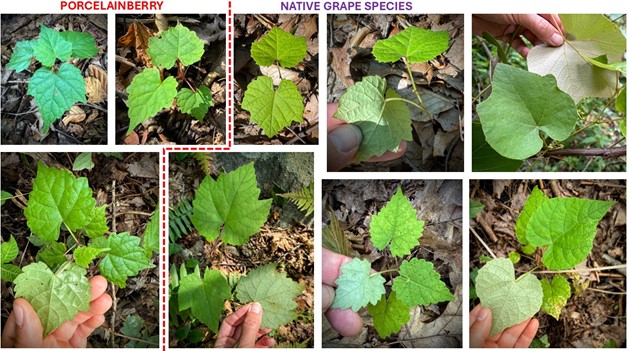
Photo credits: Jean Epiphan
Porcelainberry leaves have a glossy underside.
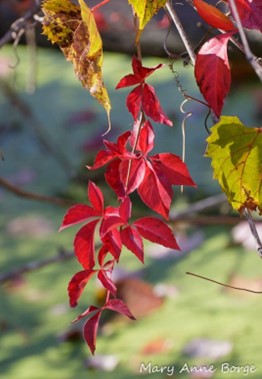
Photo credit: Mary Anne Borge
Native Alternatives:
Virginia Creeper (Parthenocissus quinquefolia) is a good alternative. This native vine makes a quick-spreading ground cover, gently climbing over rocks and up trees. It’s easily identified by its five leaves and beautiful red color in the fall (Figure 7). It also supports many wildlife species in our local ecosystems; explore this link for more photos and info on Virginia creeper: https://the-natural-web.org/2018/10/27/virginia-creeper-is-for-the-birds/
Other native vines include:
Native grapes including: summer grape (Vitis aestivalis), fox grape (Vitis labrusca), and frost grape (Vitis vulpina).
Coral honeysuckle (Lonicera sempervirens)
Thank you to our reviewers: Michele Bakacs, Michael Van Clef, John Landau, and Trish Maguire
References and Resources
New Jersey Invasive Species Strike Team Factsheet – Friends of Hopewell Valley Open. Space. New Jersey Invasive Species Strike Team Fact Sheets
Porcelain berry – Minnesota Department of Agriculture. https://www.mda.state.mn.us/plants/pestmanagement/weedcontrol/noxiouslist/porcelainberry
Porcelainberry – Plant Conservation Alliance’s Alien Plant Working Group. https://www.vtinvasives.org/sites/default/files/fact-sheets/PorcelainberryTreatmentSheet.pdf
Invasives in Your Woodland: Porcelain-berry – University of Maryland Extension. https://extension.umd.edu/resource/invasives-your-woodland-porcelain-berry-updated-2025/
Porcelain Berry, an Unwanted Beauty – Penn State Extension. https://extension.psu.edu/porcelain-berry-an-unwanted-beauty
Insidious, Monstrous Porcelain Berry, Buckeye Yard & Garden Online – Ohio State University. https://bygl.osu.edu/node/2551
The goal of Rutgers Cooperative Extension’s “Invasive Species of the Month” is to highlight those organisms that are non-native to New Jersey and cause economic or environmental harm, or harm to human health. We can all help prevent the spread of invasives by learning which species are a threat to our ecosystems.